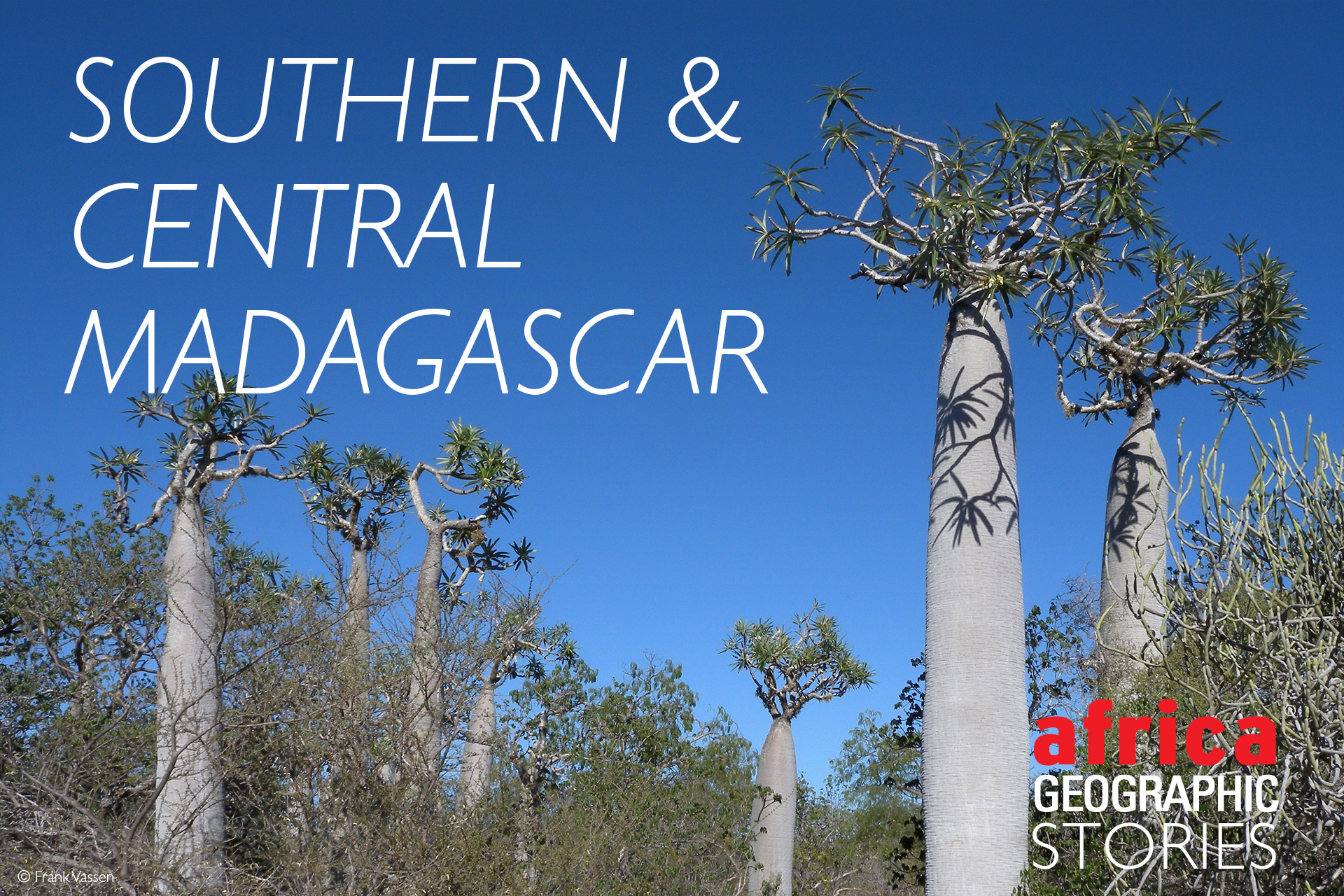
spiny forests, sifakas & desert canyons

![]()
This time we adventure to southern and central Madagascar, in our four-part series on this wondrous island. See the resources section at the end of this story for the other three stories in the series.
For the last 88 million years, life on Madagascar has been on its own – creating an island of evolutionary oddities and myriad diverse travel experiences. Sometimes referred to as a “Noah’s Ark” or the “eighth continent” due to its geographic isolation and high levels of endemism, the island of Madagascar is, simply put, enormous. It is approximately 587,000km2 (around two and a half times the size of the United Kingdom). A combination of ocean currents and dramatic topography has created a tapestry of different climates and habitats perfectly suited to the island’s peculiar inhabitants (or the other way round).
The island is home to over 300 recorded birds (60% of which are endemic) and 260 species of reptile – including two-thirds of the world’s chameleon species. There are over 110 species of lemurs spread throughout Madagascar’s protected areas, in a variety of shapes and sizes but all possessing a shared, wide-eyed charisma. Six of the world’s eight baobab species occur only in Madagascar. All in all, the natural history is unique, shaped by the fascinating and beautiful, isolated island habitats.
In an ideal world, a trip to Madagascar would extend over weeks to give the curious traveller every opportunity to explore the magnificent island. Realistically, however, time is usually limited and deciding where to invest one’s attention is guaranteed to create a significant traveller’s quandary. This four-part series is intended to help guide this decision.

South and central Madagascar
Madagascar’s ancient geography – shaped by volcanic forces and tectonic tearing – consists of a rather thin band of coastline, the massive central plateau and several massifs scattered across the island. The eastern section is lush and green, watered by Indian Ocean trade winds and with the forested escarpment descending in a series of steep steps to the rugged coastline. Further west, the arid highlands and grasslands of central Madagascar are riven by stark desert canyons. The weather becomes even drier as the land slopes gently to the island’s southern tip, giving way to the strange and formidable plants of the Tolkienesque spiny forests.
The southern circuit of Madagascar is more popular with tourists and includes two of the island’s most famous parks: Ranomafana and Isalo National Parks. Away from the main holidaymaker routes, the south-central highlands offer a vast but intimidating adventure for intrepid and experienced explorers. However, the more circumspect traveller will find these more accessible destinations provide a great fill of Madagascar’s wondrous wildlife and sublime scenery.


Ranomafana National Park
Situated on the precipitous slopes of the High Plateau, the forests of one of Madagascar’s largest national parks cover an area of around 416km2 (41,600 hectares). The name comes from the Malagasy term for ‘hot springs’ (‘rano’ meaning water and ‘mafana’ meaning warm), in which visitors can soak aching muscles after hiking the undulating and sometimes strenuous trails. Ranomafana and Berenty Private Reserve (see below) are absolute musts when visiting this part of Madagascar. The park is part of the Rainforests of the Atsinanana UNESCO World Heritage Site – a serial property composed of six national parks protecting relict forests along the eastern strip of Madagascar and known for their exceptional biodiversity. The other five parks are Masoala National Park, Marojejy National Park, Zahamena National Park, Andringitra National Park, and Andohahela National Park.
Ranomafana owes its existence to Dr Patricia Wright and her discovery of the golden bamboo lemur in 1986. This prompted the authorities to declare the region a national park and helped save the dwindling populations of one of the most unusual primates in the world. As a result, the critically endangered golden bamboo lemur is probably the park’s star character. Their main claim to fame is that they are the only primate specialising in a bamboo diet (chimpanzees and gorillas eat bamboo, but it does not form the basis of their diets). No one fully understands how they process the enormous quantities of cyanide present in the bamboo shoots’ soft stalks and growing tips. Experts estimate that they ingest approximately 50 times the lethal dose for a similarly sized mammal every day.
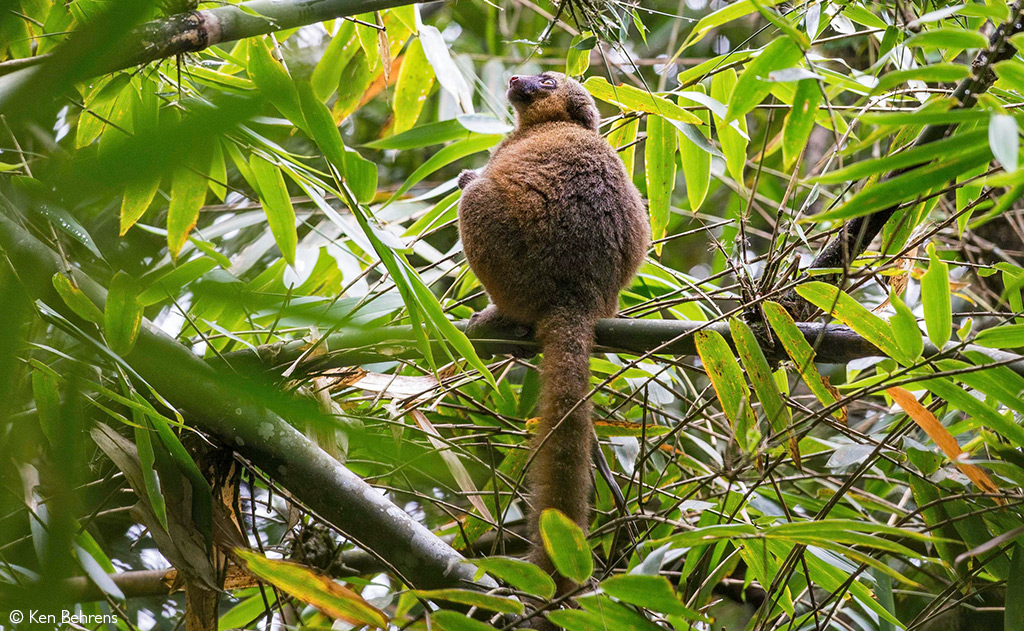
Apart from the cyanide guzzling golden bamboo lemurs, Ranomafana is home to many other lemur species, including the eastern woolly lemur, eastern grey bamboo lemur, red-bellied lemur, greater bamboo lemur, black-and-white lemur, red-fronted brown lemur, ruffed lemur, small-toothed sportive lemur, and the Milne-Edwards sifaka. The bushbaby-like mouse lemurs are undoubtedly the forest’s cutest offering – emerging at night with the eerie aye-ayes (for fortunate travellers) to take advantage of the plethora of insect life. Ayes-ayes are most easily seen near Tamatave.
Madagascar is an incredible birding destination, with at least five endemic bird families: vangas, ground-rollers, cuckoo rollers, Malagasy warblers and mesites. Though the forests (and birding opportunities) of Ranomafana are similar to those of Andasibe-Mantadia, Ranomafana offers the best chance to spot (among others) the yellow-bellied sunbird-asity, the cryptic warbler, and Madagascan snipe. Of course, this being Madagascar, the reptiles (especially chameleons) are many and varied, and the waterways and forest paths are dotted with colourful little frogs. The aptly named giraffe-necked weevils are another Madagascan endemic – a peculiar insect with an elongated neck designed for nest building and fighting off rivals.
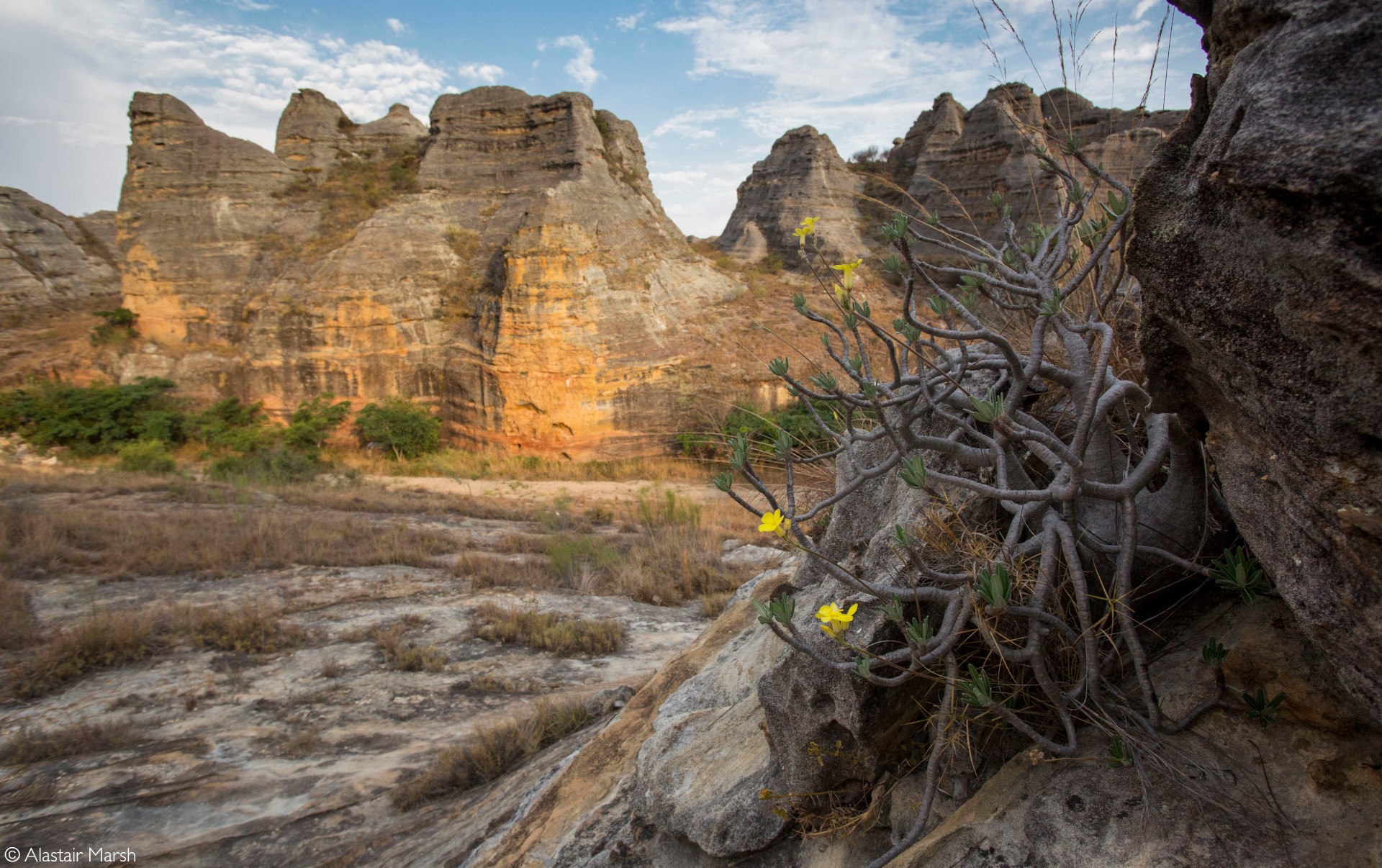
Isalo National Park
Delving further into Madagascar’s interior, the 815km2 (81,500 hectares) Isalo National Park is a world apart from the tropical rainforests of the east. Hot and dry though it may be, Isalo is one of Madagascar’s busiest parks for a reason. The views are different every day, with shifting shadows and changing colours creating a living work of art as the sun moves across the sky. Isalo boasts wooded ravines, idyllic pools like “Piscine Naturelle”, and incredible flora. The park is also very close to the main road.
Isalo is often described as Madagascar’s equivalent of the Grand Canyon, though this is probably a slight overstatement. Regardless, the scenery is not dissimilar to Arizona’s in the US, complete with dramatic canyons and colourful sandstone ridges. The sweeping panoramas can be explored across several different hikes ranging from a few hours to several days in duration. Some magnificent trails also descend into the sclerophyllous (hard leaved, drought-adapted) woodlands of the gorges to arrive at limpid pools where visitors can refresh body and soul.
Here tourists delight in the antics of the park’s ring-tailed lemurs. They’re unlikely to bust out any dance moves or speak with Sasha Baron Cohen’s inexplicable Indian accent like DreamWorks’s famous (mis)representation, but these black and white lemurs are equally sassy. From the endemic and distinctive elephant’s foot (which looks a bit like a bulbous bonsai baobab) to several native species of aloe, the plant life is unique and fascinating. Recent studies indicate that the park is home to 24 different amphibian species, 47 reptiles, and over 100 different bird species have been recorded in Isalo.
All this said, seeing birds and mammals in Isalo can be tricky. An excellent birding option is Zombitse-Vohibasia National Park, where expert bird guides will delight you with incredible sightings of giant couas, cuckoo-rollers, the highly restricted Appert’s greenbul and myriad non-venomous snakes and endearing chameleons.


Tsimanampetsotsa National Park
No discussion of southern Madagascar would be complete without mentioning the island’s seemingly inhospitable but enthralling spiny forests (cover image above). Situated in the south-western corner of Madagascar, the 432km2 (43,200 hectares) Tsimanampetsotsa National Park lies in the driest part of the country and protects a section of this unique ecoregion. This is a difficult area to access, but it is not impossible – you can catch a boat to Anakao from Toliara and then a four-wheel-drive or open truck tour from Anakao to the park. The park can only be accessed by road. One has to wonder at the various pronunciations of the name local taxibrousse (a Malagasy bush taxi) drivers must have heard from eager tourists. Tsimanampetsotsa takes its name from Lake Tsimanampetsotsa – the “lake in which no dolphins live”. There are indeed no dolphins in the salty waters, but at certain times of the year (April-November), the alkaline lake is covered in a pink flush of greater and lesser flamingos.
Tsimanampetsotsa is also home to one of the rarest carnivorans in the world: the Grandidier’s mongoose (also known as the giant-striped mongoose or Grandidier’s vontsira). As playful and bold as any mongoose species, they are commonly seen at campsites searching for scraps. They are not found anywhere else on the island.
Away from the sacred salt lake and associated wetlands, the landscape changes to the sparse dry woodlands that define the ecoregion of southern Madagascar. The region boasts exceptionally high levels of plant endemism, with an estimated 95% of plant species classified as endemic. These include the unmistakable octopus trees (Didierea madagascariensis) – a kind of woody semi-succulent not dissimilar to a cactus. They sport enormous and vicious-looking thorns, but this does little to deter the groups of critically endangered Verreaux’s sifaka from clambering and leaping between them. With their profoundly disproportionate limbs, these sifakas are designed for arboreal life, and when moving across the ground, they are forced to do a two-legged canter on their back legs, with arms thrust out to the side for balance.
Scattered within the dry forest plant life are the brooding outlines of ancient, squat baobabs. Known as fony (sacred) baobabs (Adansonia rubrostipa), these trees are fascinating ecosystems in their own right. An ancient baobab, nicknamed the “Grandmother” (or “Mother of the Forest”), has recently been revealed to consist of three different, fused trees: one 200 years old, one 1,000 years old and the oldest being 1,600 years old. The roadrunner-like long-tailed ground-roller dashes around at the base of these trees, its wings lined by bright blue streaks. In the Mitoho Grotto, a hidden cave, blind sleeper goby fish still swim the freshwater pools, isolated forever. Here, fossils bear testament to a time when giant lemurs the size of small gorillas once roamed.
One need not travel to Tsimanampetsotsa if it is a little out of the way and time is limited. A few kilometres north of Toliara, in the Ifaty area, there are great lodges, a reef, guides and bird guides that will show you Didierea and baobabs along with all the bird endemics the area has to offer.
Berenty Reserve
On the banks of the Mandrare River, the small private Berenty Reserve also protects around a third of Madagascar’s remaining tamarind gallery forest. It is a popular destination for visitors looking for close encounters of the lemur kind – ring-tailed lemurs are the true stars of Berenty. Lucky visitors might be treated to a sighting of a Verreaux’s sifaka’s “dancing” movements. Other great fauna to look out for in Berenty include Dumeril’s boa, Madagascar flying fox, sickle-billed vangas and running coua.
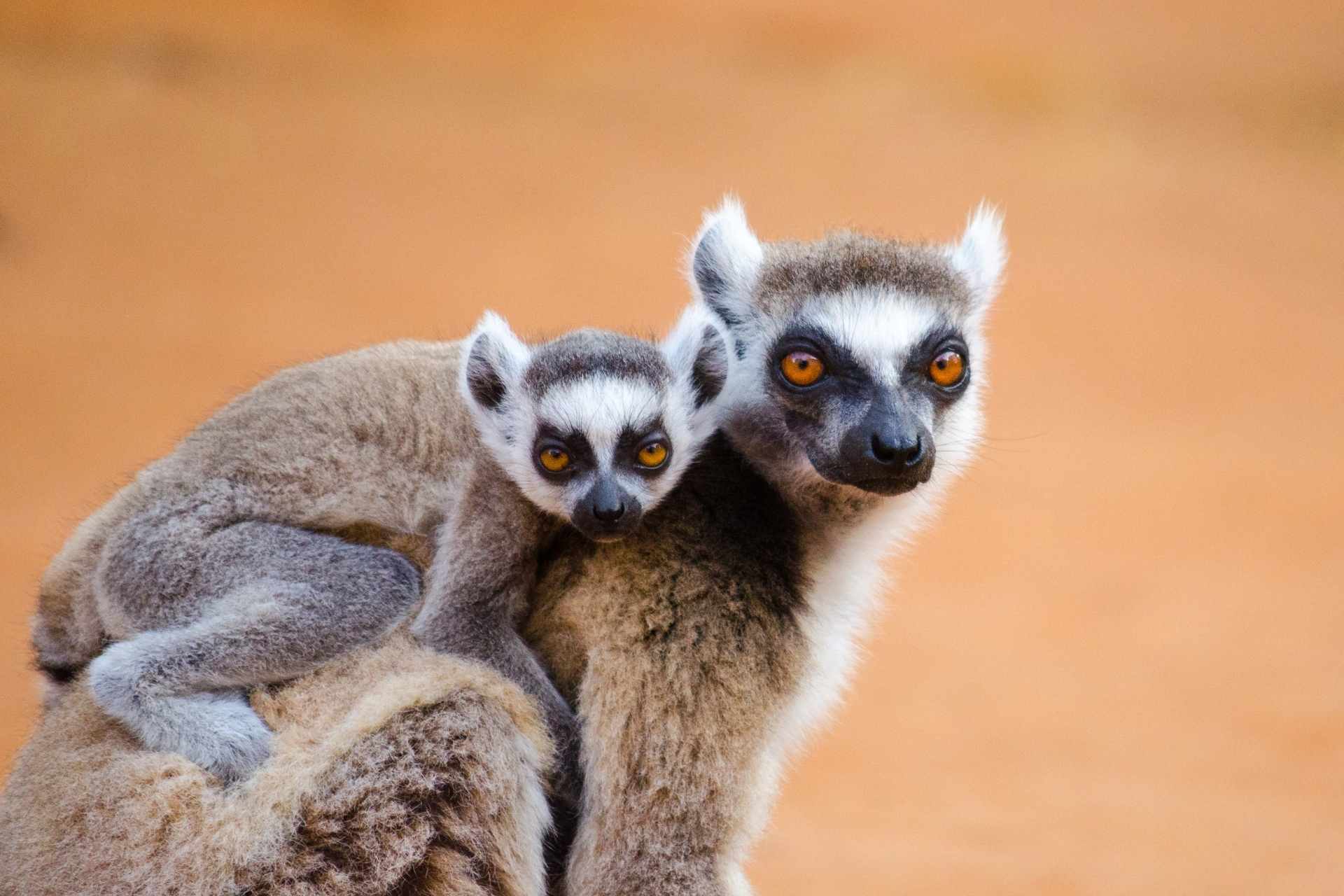
The ins and outs of exploring southern Madagascar
Want to go on safari? to Madagascar? To find lodges, search for our ready-made packages or get in touch with our travel team to arrange your safari, scroll down to after this story.
Madagascar’s tropical climate is typically enjoyable all year round. However, the wet season and tropical cyclones during the summer (November to March) can make Ranomafana National Park inaccessible. The cooler dry season from April until October alleviates the worst of the oppressive heat, which is particularly important when exploring the island’s central highlands or southernmost tip where temperatures regularly exceed 35–40˚C. You will need just over two weeks to explore this part of Madagascar.
There are plenty of budget and camping opportunities in or near all of the major parks, but luxury accommodation is relatively sparse. An exploration of Madagascar is often a rough and ready experience. It is advisable to travel in Madagascar with a reputable company, but hiring a car to drive between the various attractions is possible. The roads are bad, particularly during the wet season, and a 4×4 is essential. Parts of the central plateau are dangerous to travel through, and it is advisable not to travel alone without being well informed.
Land of plenty
Madagascar is a fantastical land – a natural evolutionary playground and a human kaleidoscope of cultural influences. Remarkable, offbeat, and enticing, this magical island offers an intoxicating combination of unique wildlife viewing and magnificent scenery. There is far more to Madagascar than our series could ever hope to convey, but there is no question that it is a country with something to offer every nature enthusiast. Our travel consultants are always on standby to help you plan the Madagascan holiday of your dreams.
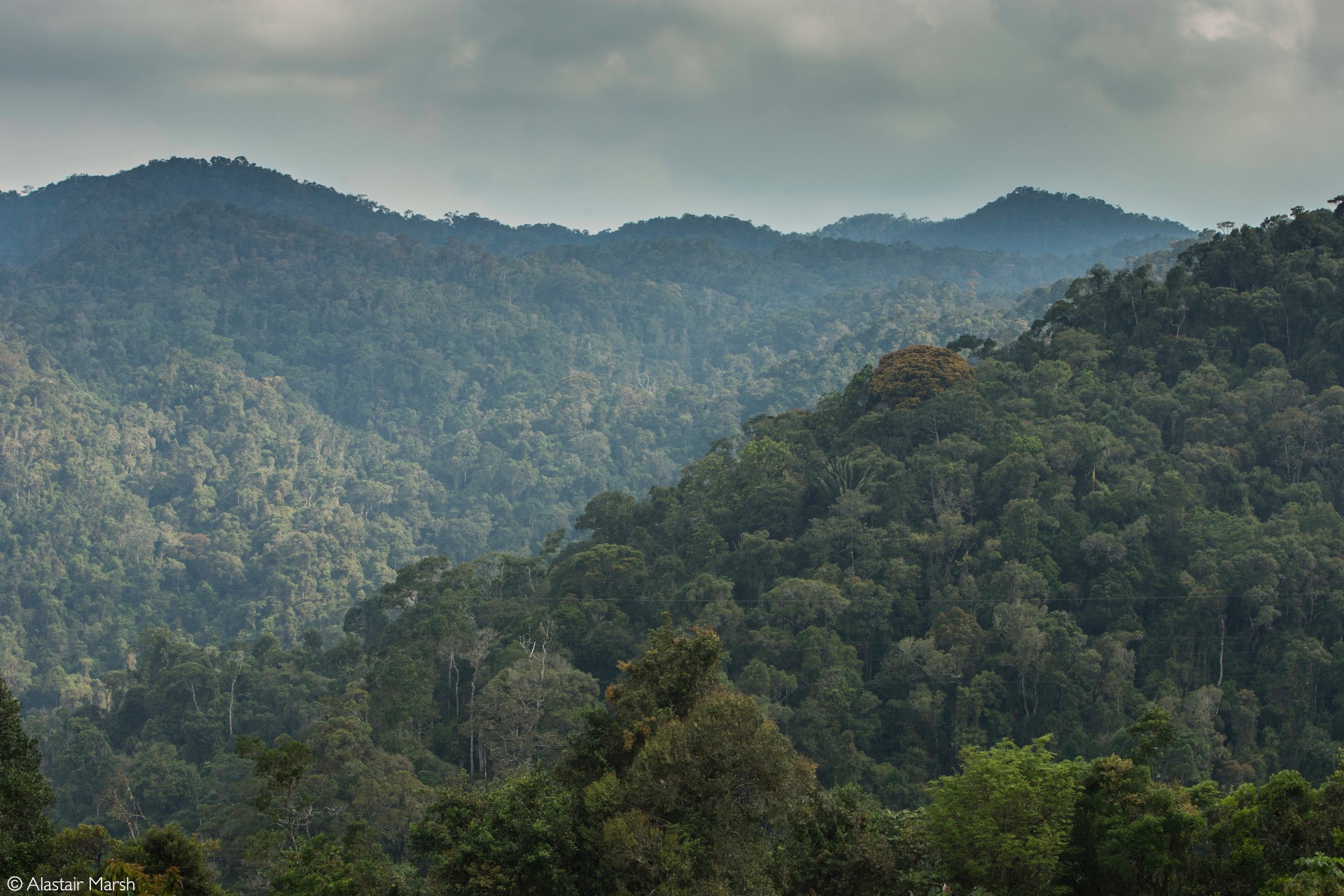
Want to plan your safari? Get in touch with our travel team to start the discussion.
Check out our preferred camps & lodges for the best prices, browse our famous packages for experience-based safaris and search for our current special offers.
Resources
Photographers
Ken Behrens is a birder, naturalist, consultant, guide, and photographer, who is based in Madagascar. He is the co-author of several books, including Wildlife of Madagascar. His work can be seen at ken-behrens.com
Alistair Marsh’s photography can be seen and purchased from www.alastairmarsh.co.uk

To comment on this story: Login (or sign up) to our app here - it's a troll-free safe place 🙂.![]()




